Georges Cziffra, pianist

György Cziffra naît le 5 novembre 1921 à Budapest dans une famille tsigane. Il grandit dans la misère et apprend seul à jouer sur le piano droit acheté par sa sœur avec ses premières économies. Il commence à jouer à cinq ans dans des cirques. Sa virtuosité et son sens de l’improvisation le font remarquer de l’Académie de musique Franz Liszt où il entre à neuf ans en dépit des lacunes de sa formation classique.
En 1942, il est envoyé sous les drapeaux et son unité part combattre sur le front russe avec les forces de l’Axe comme les 200.000 hommes que la Hongrie engage sur le Front de l'Est. Evadé, il est capturé par les Russes et emprisonné deux ans. En 1946, il est démobilisé. Il tente de fuir l’occupation soviétique en 1950 mais est capturé et condamné à trois ans de travaux forcés, qu’il passe dans une carrière, à déplacer la main des blocs de pierre. En 1956, à la veille de l’intervention soviétique à Budapest, il peut enfin fuir le pays avec sa femme et son fils. Reconnu réfugié en 1957 par l’Ofpra, il s’installe dès lors en France. Naturalisé français en 1968, installé à Senlis, il devient Georges Cziffra.
Cziffra est un symbole du génie pianistique que la folie des sociétés humaines, des guerres et des persécutions n’aura pas réussi à détruire. Virtuose, il doit, du fait des séquelles des travaux forcés travailler avec des atèles en cuir en guise de prothèses et à se présenter en public avec son bracelet de cuir, devenu légendaire. Il fonde en 1966 le festival de musique de La Chaise-Dieu en Auvergne. Avec ses cachets, il fait l’acquisition de l'ancienne chapelle gothique de Saint-Frambourg à Senlis et transforme ce lieu, en 1975, en la Fondation Cziffra, qui œuvre inlassablement pour les jeunes artistes, surtout musiciens mais aussi sculpteurs et peintres.
Dans son autobiographie parue en 1977, Des canons et des fleurs, il retrace les étapes significatives de son parcours. Il meurt en 1994.